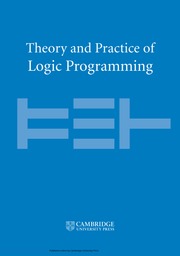Crossref Citations
This article has been cited by the following publications. This list is generated based on data provided by
Crossref.
Basu, Kinjal
2019.
Conversational AI : Open Domain Question Answering and Commonsense Reasoning.
Electronic Proceedings in Theoretical Computer Science,
Vol. 306,
Issue. ,
p.
396.
Varanasi, Sarat Chandra
2019.
Imperative Program Synthesis from Answer Set Programs.
Electronic Proceedings in Theoretical Computer Science,
Vol. 306,
Issue. ,
p.
413.
Arias, Joaquín
Chen, Zhuo
Carro, Manuel
and
Gupta, Gopal
2020.
Logic-Based Program Synthesis and Transformation.
Vol. 12042,
Issue. ,
p.
139.
Basu, Kinjal
Varanasi, Sarat Chandra
Shakerin, Farhad
and
Gupta, Gopal
2020.
SQuARE: Semantics-based Question Answering and Reasoning Engine.
Electronic Proceedings in Theoretical Computer Science,
Vol. 325,
Issue. ,
p.
73.
Cabalar, Pedro
Fandinno, Jorge
and
Muñiz, Brais
2020.
A System for Explainable Answer Set Programming.
Electronic Proceedings in Theoretical Computer Science,
Vol. 325,
Issue. ,
p.
124.
Arias, Joaquín
Carro, Manuel
Chen, Zhuo
and
Gupta, Gopal
2020.
Justifications for Goal-Directed Constraint Answer Set Programming.
Electronic Proceedings in Theoretical Computer Science,
Vol. 325,
Issue. ,
p.
59.
Varanasi, Sarat Chandra
Salazar, Elmer
Mittal, Neeraj
and
Gupta, Gopal
2020.
Logic-Based Program Synthesis and Transformation.
Vol. 12042,
Issue. ,
p.
75.
Saribatur, Zeynep G.
Eiter, Thomas
and
Schüller, Peter
2021.
Abstraction for non-ground answer set programs.
Artificial Intelligence,
Vol. 300,
Issue. ,
p.
103563.
Morris, Jason
2021.
Constraint answer set programming as a tool to improve legislative drafting.
p.
262.
Stéphan, Igor
2021.
First-order ASP programs as CHR programs.
p.
881.
Arias, Joaquín
Moreno-Rebato, Mar
Rodriguez-García, Jose A.
and
Ossowski, Sascha
2021.
Advances in Artificial Intelligence.
Vol. 12882,
Issue. ,
p.
258.
Hall, Brendan
Varanasi, Sarat Chandra
Fiedor, Jan
Arias, Joaquín
Basu, Kinjal
Li, Fang
Bhatt, Devesh
Driscoll, Kevin
Salazar, Elmer
and
Gupta, Gopal
2021.
Knowledge-Assisted Reasoning of Model-Augmented System Requirements with Event Calculus and Goal-Directed Answer Set Programming.
Electronic Proceedings in Theoretical Computer Science,
Vol. 344,
Issue. ,
p.
79.
PENDHARKAR, DHRUVA
BASU, KINJAL
SHAKERIN, FARHAD
and
GUPTA, GOPAL
2022.
An ASP-based Approach to Answering Natural Language Questions for Texts.
Theory and Practice of Logic Programming,
Vol. 22,
Issue. 3,
p.
419.
Tammet, Tanel
Draheim, Dirk
and
Järv, Priit
2022.
Automated Reasoning.
Vol. 13385,
Issue. ,
p.
300.
WANG, HUADUO
SHAKERIN, FARHAD
and
GUPTA, GOPAL
2022.
FOLD-RM: A Scalable, Efficient, and Explainable Inductive Learning Algorithm for Multi-Category Classification of Mixed Data.
Theory and Practice of Logic Programming,
Vol. 22,
Issue. 5,
p.
658.
Varanasi, Sarat Chandra
Arias, Joaquín
Salazar, Elmer
Li, Fang
Basu, Kinjal
and
Gupta, Gopal
2022.
Practical Aspects of Declarative Languages.
Vol. 13165,
Issue. ,
p.
181.
Arias, Joaquín
Carro, Manuel
Salazar, Elmer
and
Gupta, Gopal
2022.
Proceedings 38th International Conference on Logic Programming.
Electronic Proceedings in Theoretical Computer Science,
Vol. 364,
Issue. ,
p.
172.
ARIAS, JOAQUÍN
CARRO, MANUEL
CHEN, ZHUO
and
GUPTA, GOPAL
2022.
Modeling and Reasoning in Event Calculus using Goal-Directed Constraint Answer Set Programming.
Theory and Practice of Logic Programming,
Vol. 22,
Issue. 1,
p.
51.
Arias, Joaquín
Carro, Manuel
and
Gupta, Gopal
2022.
Practical Aspects of Declarative Languages.
Vol. 13165,
Issue. ,
p.
117.
Wang, Huaduo
and
Gupta, Gopal
2022.
Functional and Logic Programming.
Vol. 13215,
Issue. ,
p.
224.


